
Pamperin Cigar Company
(written by Scott Brouwer, Archives staff)
Cigar manufacturing was a thriving industry in La Crosse shortly after the turn of the 20th century that employed hundreds. The Pamperin Cigar Company, recognized regionally and nationally for its excellent tobacco products, operated in downtown La Crosse for over 120 years.

La Crosse Tribune 19 December 1916
John Pamperin came to La Crosse in 1866 from Watertown, WI, with 3 cigarmakers and a small stock of tobacco. He rented a small frame building near 2nd and Pearl and established his business, known then simply as John Pamperin cigar manufacturer. In two short years, he built a sizeable customer base and had to expand to a bigger brick building in the 200 block of Main Street, adding a third story to the existing building to accommodate the growing firm. The new third floor was used as the factory where raw material was weighed out and distributed to the makers rolling the final products. The second floor was used as a stock room, while the first floor was a store and display room.
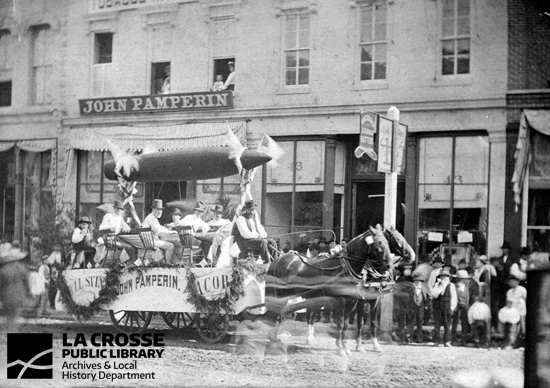
John Pamperin cigar manufacturer 4th of July parade float in front of the John Pamperin factory, 221-223 Main Street, 1876
Eugene Wiggenhorn, co-owner of Wiggenhorn Bros. cigar manufacturers in Watertown, WI, purchased an interest in the company in 1886. The capacity was increased and the name of the firm changed to The Pamperin & Wiggenhorn Company. At the time of the new incorporation, it was noted that between 75-80 employees earned an aggregate $32-35,000 annually, with about 50 cigarmakers turning out nearly 12,000 cigars daily. A factory inspector paid the following compliment to management in his 1886 report: “The factory is in elegant condition with ample means of escape; the firm prides itself on the neat and clean condition of their factory, and well they may. I have seen no factory of the kind to surpass it.” (La Crosse Daily Press 4 July 1891, p3)

Pamperin & Wiggenhorn Company employees, 221-223 Main Street, 1890

Pamperin & Wiggenhorn Company factory, 221-223 Main Street, ca. 1890s
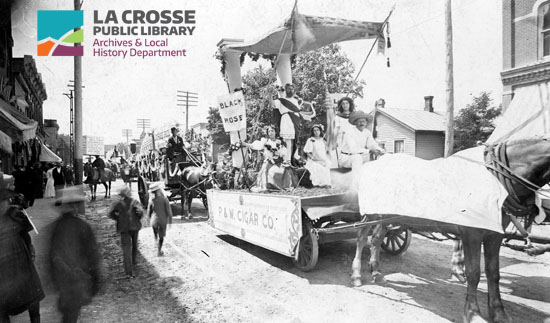
Pamperin & Wiggenhorn Company 4th of July parade float, 1898
In 1904, Wiggenhorn’s sons bought out the Pamperin interests in the Main Street factory. At the same time, Pamperin and his two sons opened the new Pamperin Cigar Company at their historic location in downtown La Crosse, 113 2nd Street South. The company soon expanded into the leaf tobacco business, acquiring a warehouse at 12th and Green Bay Streets.
The company produced numerous brands of cigars, but the La Roma and Black Rose were their most popular and were “favorably known to the trade and are considered staple articles by […] dealers”. The La Crosse County Historical Society has a Black Rose cigar box in its collection and featured it in its “Things That Matter” column in the La Crosse Tribune.
Photo courtesy of La Crosse County Historical Society
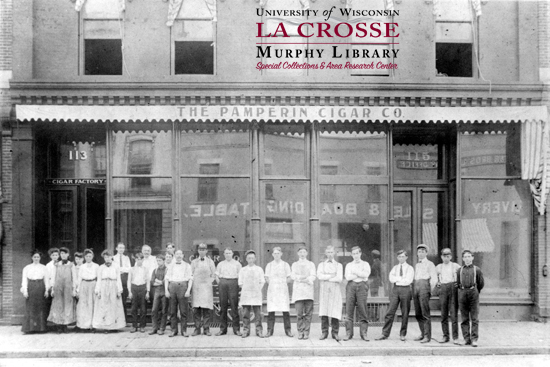
Pamperin Cigar Company employees, 113-115 2nd Street South, date unknown

Pamperin Cigar Company employees, 113 2nd Street South, 1906
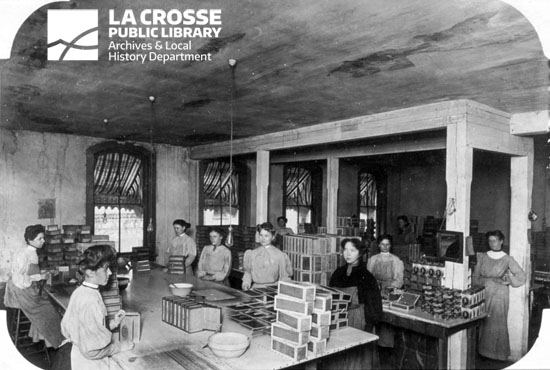
Pamperin Cigar Company employees, 113 2nd Street South, 1912
By 1945, the handcrafted cigar industry was no longer profitable with the introduction of automatic cigar rolling machines and cigarette usage on the rise. The Pamperin Cigar Company was the last of the major cigar manufacturers in La Crosse to call it quits. It transitioned into producing chewing and smoking tobacco. The company entered into agreements with major east coast cigar factories to ship scraps from their manufacturing processes to La Crosse. By the 1960s, the Pamperin Cigar Company was manufacturing chewing and smoking tobacco under about 40 different brand names distributed and sold all over the Midwest. The nearest competitors at the time were in Detroit and St. Louis. Pamperin employed between 10-15 packers, mostly women, with each packer capable of producing up to 1,000 packs per day.

La Crosse Tribune Family Magazine cover 25 August 1963
Charles and Marjorie Collins bought the company in 1974, ending over 100 years of Pamperin family ownership. Marjorie later noted that she wasn’t quite sure what to expect from the company’s longtime employees, as it was the first time in almost 100 years that a woman had walked into the office to take charge: “I just stood in the door and waited for somebody to say hello, or welcome, or something.” (La Crosse Tribune 11 November 1975, p8)
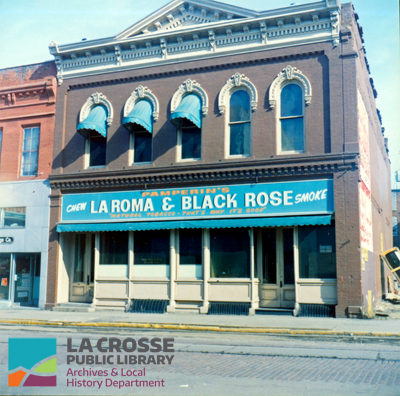
113 2nd Street South, 1970

113 2nd Street South, 1970
The Pamperin Cigar Company closed its doors in December 1986, having sold the last four Pamperin brands of chewing tobacco to The Finck Cigar Co. of San Antonio, Texas. Among the many things documented by Marjorie Collins upon the its closure were a 1903 certificate of registered trademark for a private brand of cigar made for the Stoddard Hotel in downtown La Crosse and a Himoff brand tobacco cutter purchased in 1939, the last piece of new equipment bought by the Pamperin family.

La Crosse Tribune 13 December 1986
The Pamperin Cigar Company building, 113 2nd Street South, has been a La Crosse City Landmark property since 1995. The building has recently been the home of the Kick Shoes boutique store and The Toy Shop, an independent, family-owned store.
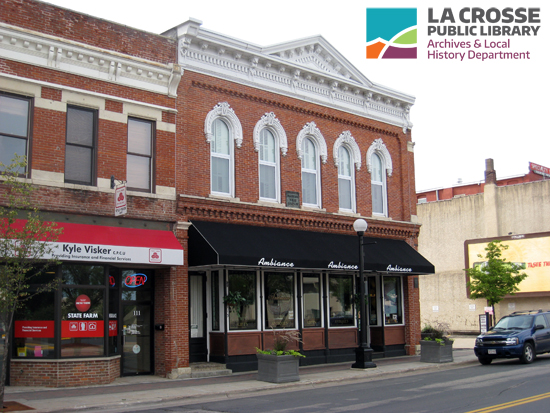
113 2nd Street South, 2008 - photo taken by Eric Wheeler
The Main Street location of the earlier John Pamperin cigar factory, later the Pamperin & Wiggenhorn Company, was razed in the early 1980s to make room for the city parking ramp on the NW corner of 3rd and Main Streets originally built to accommodate employees and customers of the businesses in First Bank Place, now the U.S. Bank Place building.

